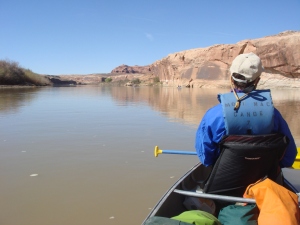John shuffles and spreads the animal medicine cards in a fan before me. Pausing for a few seconds, I carefully select one of thirty at random. Butterfly: the master of transformation. First an egg, then a larvae, a cocoon, and finally, a rebirth as a entirely new being. The card asks its receiver some questions. Is there a decision that needs to be made in your life, an idea that requires forming, or has that idea developed enough to share it with the world and make a difference in the lives of others?
The river is a master of transformation. As its waters ebb and flow with the seasons, the land around it succumbs to the powerful changes. The currents deposit cobbles and gravel on the outer curves, while the inlet banks form into vegetative beaches that gradually rise up the sides. The water has carved rock slowly but definitively, creating the steep canyon walls that we gaze up at while floating downstream in our canoes. Thinking of what this land looked liked thousands or millions of years ago seems impossible.
The riparian habitat lines the banks, gravitating toward its most crucial source of sustenance, water. This habitat, which makes up only about 3% of the land in this region, is essential to about 80% percent of the life. The river has ensured the vitality of its banks, changing what would be sand and a few shrubs, to a dense layer of plant and animal life. This section is the median between river and upland, the vital connection between desert and water body. This river has total control over its immediate environment. It is a master of transformation.
When the spring floods come, the banks drown in a rush of fresh snowmelt and rainwater, and the flora and fauna are more than happy to accept the high waters. Over time, they have adapted to depend on the seasons. Fremont cottonwood trees wait for the floods to disperse their seeds not only because the water will carry the seeds downstream, but in order to germinate, they must be implanted in wet soil. Understanding the control of the river, life willingly adjusts its ways to properly balance the ecosystem, and ensure its sustainability for the future. When the hot and dry summers roll around, the plants and animals are prepared to adapt once again to the rivers continual mood swings.
Butterflies undergo a process of transformation that begins the second they are laid as an egg. They grow into larvae, then a caterpillar, munching away at leaves carelessly. Suddenly, without ever knowing what they’ve been preparing for their whole lives, change is knocking at their door. But do they resist and stay a caterpillar forever or with no assurance of what the future holds, allow the new stage to take over and hope for the best? With an innate understanding, the worm locks itself away in hiding, far from the influence of others and completes a transformation it’s been waiting a lifetime to finish.
When we feel a change is coming, there is a desire to resist. We know we have to evaluate our lives, and act on it. Change is difficult; it challenges everything we’ve built up to that point and makes us uneasy of the future. It all comes down to this: those that resist the shifts get left behind. Those that embrace them with open arms and don’t look back not only last through the rough times, they emerge better than they ever thought was possible.
